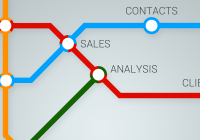When he took over the steering wheel of Microsoft, Global CEO, Satya Nadella stated “Every business will be a software business”. He was on the mark. Looking at the world around us, every business is indeed a software business.
Since software is an integral component of every business, it is important to make business decisions keeping the ‘software dimension’ in mind. Equally the ‘core business dimension’ must also be considered.
Regardless of whether you develop the software or buy and run it, to run a business successfully, you need to make your own decisions. These decisions must be informed by both your core business expertise and the data. But the decisions must be your own. Too often, that is not the case.
Instead, most businesses are locked in. Existing business practices and software packages prevent a business from moving itself in the right direction – a direction, beneficial to the business. A lack of responsiveness to changes – changes in the competitive environment, changes in the business’ operating climate, changes within the business’ internal fabric of operation – exacerbates the problem.
Important to note that it does not have to be this way. Managed correctly, your business operations can become a core part of empowering the enterprise while enabling and encouraging freedom of choice. Automation is the key enabler of that success.
The Connection Between DevOps and Freedom Of Choice
You are no doubt familiar with the concept of DevOps in application and software deployment. The etymology of DevOps lies in Development (as in Software Development) and Operations (as in IT Operations).
The symbiosis requires a cultural shift. In the enterprise, traditionally the Dev and Ops teams have resided and operated in silos. These silos must be amalgamated. Traditionally, they operated as individual ‘walled’ entities within the enterprise where management, processes, and information have operated within their respective walls. In today’s SaaS world, where agile is the norm, on the software development side, and on the IT operations side, there needs to be better communication and collaboration to best serve the business needs of the organisation.
The breaking down of silos is no easy feat. It requires a cultural shift and realignment. But one that comes with significant advantages. According to Amazon,
DevOps is the combination of cultural philosophies, practices, and tools that increases an organization’s ability to deliver applications and services at high velocity: evolving and improving products at a faster pace than organizations using traditional software development and infrastructure management processes. This speed enables organizations to better serve their customers and compete more effectively in the market.
DevOps in many cases focuses heavily on the “Dev” aspect. How do “Developers” achieve the outcomes they require? How can processes be streamlined so “Developers” can work more efficiently? How can “Developers” leverage the cool, new cloud-based services and technologies to deliver the outcomes that the enterprise needs?
“Operations” is often seen and portrayed as the poor second cousin, with their needs often de-prioritised in the backlog. Ongoing maintenance requirements in keeping the lights on, undertaking performance optimisation, security and compliance requirements, regular security patching and hardening, planned downtime requirements for change and release management – these are often aspects left too late in the software release lifecycle (and often forgotten when considering any project funding for new cool widgets that need to be delivered to the organisation). These two diametrically opposed viewpoints are often at logger-heads.
Development and operations working together increases opportunities for innovation, better quality and quality assurance, and improved collaboration. But these benefits can only be effectively unlocked with one core component of the concept: a common operating model. Developing the symbiotic relationship between development and operations by virtue of a common operating model underpinned by automation is the key – a common language if you like and often one that can bring two diametrically opposed in alignment.
This empowers organisations, providing both Development and Operations a freedom of choice. In an article last year, JFrog’s CEO predicted[GS1] freedom of choice to become a major trend for the cloud economy, in the near future.
How Automation Can Build Freedom Of Choice In Your Organisation
Establishing an automation capability across your platform is the keystone of a successful journey to a DevOps operational model. A vendor agnostic automation capability, such as one provided by LimePoint’s MintPress automation platform, empowers organisations and enables freedom of choice, providing you with the opportunity to choose what software to run, when, and how to run it.
On an enterprise level, that process is far from singular. Your non-production environments might be deployed and managed on the cloud (of your choice J), whilst your Production and DR environments might be deployed in on-premise private data centres. However, deployments, patches, and changes need to be managed efficiently across your SDLC for maximum success. The right platform can help with that.
At LimePoint, this is precisely what we do. We help empower the enterprise in the cloud economy. We specialise in DevOps and automation.
With automation powered products and services, we combine advanced tools and processes with extensive expertise to provide end-to-end solutions encompassing cloud, infrastructure, middleware and applications.
Get in touch with us. Allow us to empower your organisation through our DevOps and automation capabilities.



